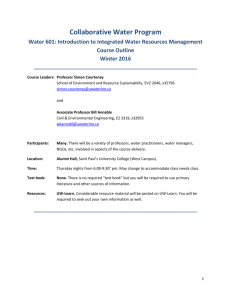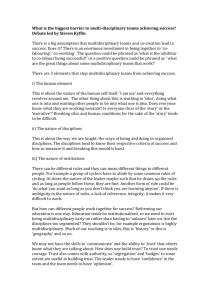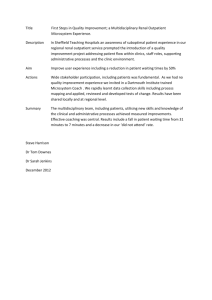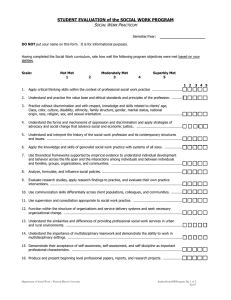Basic Elements of Multidisciplinary Design Courses and Projects*
advertisement
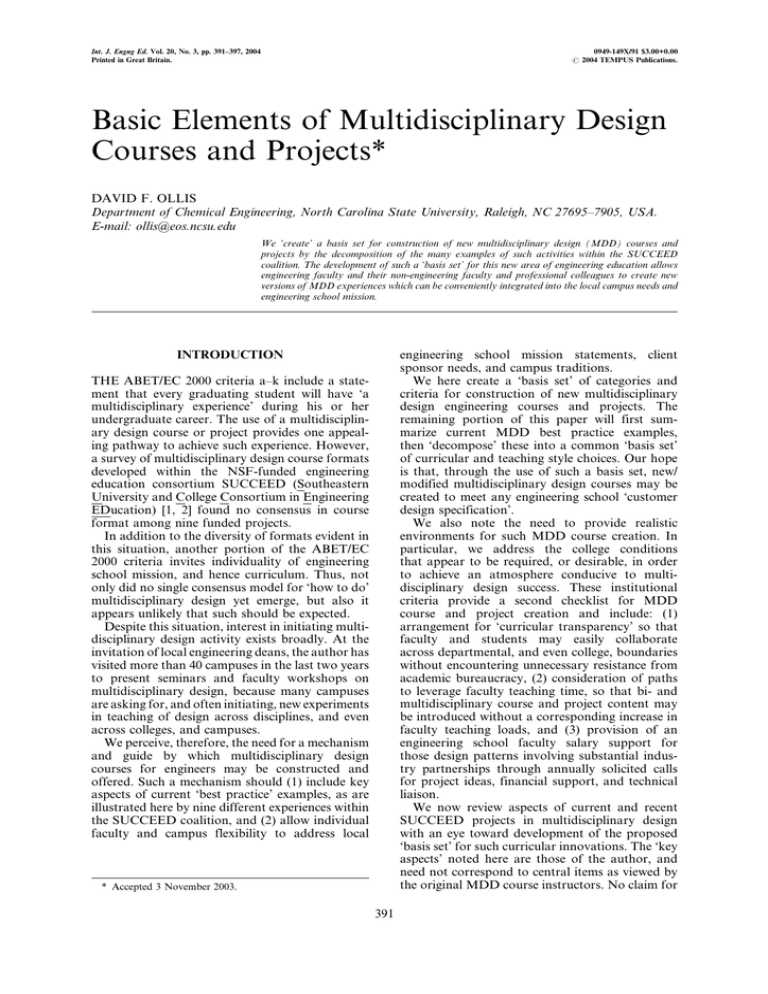
Int. J. Engng Ed. Vol. 20, No. 3, pp. 391±397, 2004 Printed in Great Britain. 0949-149X/91 $3.00+0.00 # 2004 TEMPUS Publications. Basic Elements of Multidisciplinary Design Courses and Projects* DAVID F. OLLIS Department of Chemical Engineering, North Carolina State University, Raleigh, NC 27695±7905, USA. E-mail: ollis@eos.ncsu.edu We `create' a basis set for construction of new multidisciplinary design (MDD) courses and projects by the decomposition of the many examples of such activities within the SUCCEED coalition. The development of such a `basis set' for this new area of engineering education allows engineering faculty and their non-engineering faculty and professional colleagues to create new versions of MDD experiences which can be conveniently integrated into the local campus needs and engineering school mission. engineering school mission statements, client sponsor needs, and campus traditions. We here create a `basis set' of categories and criteria for construction of new multidisciplinary design engineering courses and projects. The remaining portion of this paper will first summarize current MDD best practice examples, then `decompose' these into a common `basis set' of curricular and teaching style choices. Our hope is that, through the use of such a basis set, new/ modified multidisciplinary design courses may be created to meet any engineering school `customer design specification'. We also note the need to provide realistic environments for such MDD course creation. In particular, we address the college conditions that appear to be required, or desirable, in order to achieve an atmosphere conducive to multidisciplinary design success. These institutional criteria provide a second checklist for MDD course and project creation and include: (1) arrangement for `curricular transparency' so that faculty and students may easily collaborate across departmental, and even college, boundaries without encountering unnecessary resistance from academic bureaucracy, (2) consideration of paths to leverage faculty teaching time, so that bi- and multidisciplinary course and project content may be introduced without a corresponding increase in faculty teaching loads, and (3) provision of an engineering school faculty salary support for those design patterns involving substantial industry partnerships through annually solicited calls for project ideas, financial support, and technical liaison. We now review aspects of current and recent SUCCEED projects in multidisciplinary design with an eye toward development of the proposed `basis set' for such curricular innovations. The `key aspects' noted here are those of the author, and need not correspond to central items as viewed by the original MDD course instructors. No claim for INTRODUCTION THE ABET/EC 2000 criteria a±k include a statement that every graduating student will have `a multidisciplinary experience' during his or her undergraduate career. The use of a multidisciplinary design course or project provides one appealing pathway to achieve such experience. However, a survey of multidisciplinary design course formats developed within the NSF-funded engineering education consortium SUCCEED (Southeastern University and College Consortium in Engineering EDucation) [1, 2] found no consensus in course format among nine funded projects. In addition to the diversity of formats evident in this situation, another portion of the ABET/EC 2000 criteria invites individuality of engineering school mission, and hence curriculum. Thus, not only did no single consensus model for `how to do' multidisciplinary design yet emerge, but also it appears unlikely that such should be expected. Despite this situation, interest in initiating multidisciplinary design activity exists broadly. At the invitation of local engineering deans, the author has visited more than 40 campuses in the last two years to present seminars and faculty workshops on multidisciplinary design, because many campuses are asking for, and often initiating, new experiments in teaching of design across disciplines, and even across colleges, and campuses. We perceive, therefore, the need for a mechanism and guide by which multidisciplinary design courses for engineers may be constructed and offered. Such a mechanism should (1) include key aspects of current `best practice' examples, as are illustrated here by nine different experiences within the SUCCEED coalition, and (2) allow individual faculty and campus flexibility to address local * Accepted 3 November 2003. 391 392 D. Ollis Table 1. Multidisciplinary design formats in SUCCEED 1. Integrated Product and Process Design 2. Engineering Entrepreneurs 3. Concurrent Engineering for Horizontal Integration (Design-Build-Fly) 4. Multi-University Design Teams 5. Virtual Corporation 6. Quality Improvement Partnership 7. Cross-Disciplinary Education in User-Centered Design 8. Multidisciplinary Design in a Global Environment 9. Cross-College Collaborative Laboratory in Engineering and Art and Design completeness is made here. Our intent is to initiate a new conversation in multidisciplinary design and turn the obligations imposed by the ABET/EC 2000 criteria into a liberation to teach design by following the hearts and minds of individual faculty. The examples chosen here are illustrative, and not exhaustive, of the range of project concepts explored within SUCCEED. The titles of these individual MDD design course formats appear in Table 1. INTEGRATED PRODUCT AND PROCESS DESIGN At the University of Florida, Gainesville, Professor Heinz Fridrich (now Emeritus, formerly Vice-President of Manufacturing for IBM) created a one-year design course in 1995 involving substantial industry participation through three MDD project resources: a design challenge, an industrial liaison engineer (2±4 hrs/week average), and project funding of $15000 [3]. Deliverables over the year include in semester one `product specifications, concept generation and evaluation, a preliminary design report, a project plan, and an analytical and experimental plan and report'. In the second semester, a prototype realization and end-of-term demonstration to the industrial sponsor is provided by achievement of `a systems level design report, prototype results and report, a production sample, an acceptance test, and a final report and project documentation' [2, 3]. The course has grown since 1996 to a steady state level typically involving about 25±30 faculty and projects, and 125±150 seniors/year. The project team size is six seniors and, to date, nine disciplines have been involved. A key personnel feature of this large, industryfunded design program is the provision by the College of Engineering for a full-time manager, currently Associate Professor of Industrial Engineering, Keith Stanfill. A newer but similar industrysupported venture for a Multidisciplinary Design Clinic began at the Florida State/Florida Agricultural and Mechanical Universities joint engineering school, which supports a half-time director who is, again, a tenured engineering faculty member. University of Florida N.C. State University Georgia Tech. Clemson University (UNC-Charlotte, Univ. South Carolina, Georgia Tech.) Virginia Tech. N.C. State University Clemson University Virginia Tech. Virginia Tech. ENGINEERING ENTREPRENEURS At NCSU, a course taught since 1994 involves students teaming as engineering entrepreneurs to start up a new company based upon a new product concept [4]. The course is delivered seminar style, whereby a weekly theme (small company management, venture capital, intellectual property, etc.) is conveyed through both weekly meetings with a faculty team adviser and an invited speaker seminar on the same theme. The course enrollment is dominated by engineering seniors, but includes non-engineering majors such as those from the College of Management. Self-organized student teams must produce several written progress and oral reports over the single semester course interval; grades are awarded dependent on such reports (no written exams). The outside speakers provide not only content but context; their stories frame a course topic in particular scenarios, and these successful presenters offer, of course, heroic examples of the start-up adventure. Undergraduate freshmen, sophomores and juniors may also participate for a single unit credit; these students sign performance contracts (for some modest team task) with seniors, who in turn each have contracts with faculty advisers. Such `vertical integration' of student participants allows an early preview of design team organization, and first-hand experience in viewing both good and poor team behavior. Multi-semester participation is possible. The team may design both the product and the company, the former as a typical engineering product or process and the latter through development of a corporate business plan. DESIGN, BUILD AND FLY A senior team led by a Master's graduate student in Aeronautical Engineering undertakes participation in the AIAA annual challenge of `Design, Build and Fly' [5, 6]. These Georgia Tech teams have historically involved 10±20 students from multiple disciplines including aeronautical, mechanical, industrial and electrical engineering. Teams are graded on three components, including individual participation, written and oral Basic Elements of Multidisciplinary Design Courses and Projects report, and device aerial performance per AIAA annual specifications. The graduate student team leader receives academic credit for his/her M.Sc. requirements. The `leadership' portion is part of a five-course, required M.Sc. sequence including concurrent engineering, life cycle cost, multidisciplinary design optimization, and two aerospace system design courses. Further vertical integration involves sophomore and junior undergraduates. Performance shows also are featured during spring high-school visits, thus the `value added' by this MDD activity includes new undergraduate student recruiting as well as device realization and team formation. The creation of multiple teams leads to performance competition for the same challenge. The content of the course features a heavy emphasis on concurrent engineering, involving parallel considerations of `design for manufacturability, design for quality, design for maintenance, etc.' This course has been offered regularly for a decade. MULTI-UNIVERSITY COLLABORATION WITH SAVANNAH RIVER PROJECT A very large `client' organization, the Savannah River Project in South Carolina, is an institution capable of annual provision of many design challenges associated with nuclear power, nuclear safety, and environmental remediation [7]. Annually, since 1995, a `project list' is sent to a four-campus alliance, headed by Clemson University and including the University of South Carolina, South Carolina State University and (since 1996) Georgia Tech. Design team faculty and student membership is drawn from across the four schools, so collaboration involves frequent electronic as well as occasional face-to-face communications. The original SUCCEED investment included substantial first-year costs to establish appropriate high-speed video and data lines among the campuses. The program has grown to an appreciable size (e.g. in 1998 it involved eight faculty and 200 students). The sponsoring Savannah River client provides not only project descriptions but also project liaison engineers and on-site visits. The end-of-year finals are presentations to each faculty±client audience. As required in the Florida multidisciplinary design formats, a substantial management commitment exists here, to receive project proposals, assemble faculty and student teams of appropriate composition, and arrange lines and schedules of communication. VIRTUAL CORPORATIONS Virginia Tech has a large engineering school with few, nearby potential industry partners in design. To provide annual multidisciplinary design challenges, since 1997 its Engineering School has created two standing virtual companies, Personal Electric 393 Rapid Transit System (PERTS) and the Distributed Information Systems Corporation (DISC), which annually execute a major design project [8]. The former invites participation from electrical, mechanical, civil and industrial engineers, the latter from chemical engineering, computer science, electrical and industrial engineering as well as allied fields such as biochemical sciences. Other student majors, including business, also participate. To date, at least 25 disciplinary areas have been involved. Each design project is addressed through students manning posts in a typical corporate structure, including research and development, design, sales, management, and human resources. Higher corporate posts are occupied by seniors, and entry positions are filled by sophomores and juniors, to allow a vertically integrated experience. Within the two domains of these virtual corporations, all disciplines within engineering may be captured to allow participation in multidisciplinary projects. SUMMER TEAM INTERNSHIP Since 1991, Professor John Rust of NCSU's College of Textiles annually organizes teams, comprising 10±15 students, to spend an entire summer in residence at a major manufacturing facility [9]. Year 1994 participants included Milliken Industries and Burlington Industries (both in textiles) and Northern Telecom (telecommunications). In all cases, the industry client provided the problem description, on-site information and liaison, and also paid summer salaries of interns and faculty stewards. The `team-in-residence' lived at or near the manufacturing sites and, over the summer, was expected to produce a substantial design solution for modifications of an existing production line. Prior to the summer internship, participating students had taken a course in Quality Improvement Processes, so that these aspects of professional development appropriate to team activities and product and process improvement were rendered explicit prior to the on-site work. To date, participating institutions have included NC State, Virginia Tech, UNC-Charlotte and Clemson University, all members of the NSFSUCCEED coalition. For one such team internship, an example of direct cost to a company (Milliken) was about $50,000. In this instance, an annual estimated savings of $1.2 million could be realized via implementation of the team's proposed design solution. Evidently, from a corporate viewpoint, not all interning teams need to succeed financially in order to have a net positive outcome from an overall program. LOCAL DESIGN In 1992, industrial engineering professor Joel Greenstein created a sophomore design course, which is open to all Clemson engineering majors. 394 D. Ollis Design problems are suggested annually through collaboration with the campus Planning and Architecture Office, which has responsibility for maintenance and modification of the Clemson campus [10]. Such a collaboration provides not only a steady stream of project ideas, but also makes available, at zero-added cost, the campus planning liaison person who can supply information, experience, and ongoing advice as appropriate. The project outcomes in several instances have been accepted and modified as needed by Planning and Architecture, then implemented before the sophomore team members had graduated, leaving a fine legacy and alumni connection to the campus. As virtually all campuses will have a corresponding on-site office, such engineering school partnerships with campus planning would appear to be natural and widely possible. A related possibility could involve a campus design team with operations personnel at the HVAC campus central facility; an example monodisciplinary version of this concept is found in Chemical Engineering at the University of Florida. INTERNATIONAL TEAMING In aeronautical engineering, Virginia Tech professor James Marchman has annually led area students in bi-cultural, and at times multidisciplinary, collaborations with student teams from other countries [11]. In this format of a one-semester design challenge, each student team corresponds electronically with a partner team abroad, and the individual campuses host the visiting partner team for one week each, leading to an in-semester, bi-cultural and multidisciplinary exchange and partnership. To date, partnering engineering institutions have been drawn from Toulouse, France's aerospace center, from the University of Loughborough in England, and from Japan, the latter linkage supported in part by funding from the Boeing Corporation. COMBINING DESIGN COURSES IN TWOCOLLEGE COLLABORATION Professor Richard Goff of the first-year Engineering Program at Virginia Tech has combined his first-year engineering laboratory (LEGO kits, design/assembly) with a sophomore course on Industrial Design, located in VT's College of Art and Design [12]. The combined course is co-taught with a professor of the Art and Design College, and now annually involves 600 engineering and design students. Each design team is assigned an individual project desk in the spacious 100 desk `studio' of the Art and Design College. Over the semester, bi-disciplinary student teams explore product design and realization through parallel consideration of `design for performance' (engineering) and `the aesthetic and cultural value of manufactured objects' (art and design). A key feature of this course is its provision of a bi- or multidisciplinary experience (involving design in at least a qualitative sense) simply by the combination of two existing courses. Thus, the ABET/EC 2000 `multidisciplinary experience' criterion is addressable with faculty collaborations and synthesis of a new course within the existing space and salary budgets of the two original offerings by the participating colleges. QUANDARY: NO CONSENSUS FOUND FOR MD DESIGN At a 1998 summary conference for SUCCEED's first multi-year round of experiments in multidisciplinary design, the previous examples were all presented by enthusiastic principal investigators. My conclusions from the conference were two: . No consensus format for successful MD experiences was evident. . Even the largest, `most successful' format reached only 15% of the graduating senior class. These conclusions generate further questions: . In the absence of a consensus model for teaching multidisciplinary design, what do these SUCCEED design course formats have to offer other engineering schools? . If any single format so far cannot reach more than 15% of the seniors in a current incarnation, is utilization of any single form likely to enable an engineering school to achieve, through design offerings, compliance with ABET/EC 2000's criterion requiring that every graduating student shall have a multidisciplinary experience? . Given that ABET also allows broad discretion in forming the mission statement of each engineering school, should we even expect, under the resultant multiplicity of new college missions, that a consensus model for multidisciplinary design should emerge? QUANDARY RESOLVED: THE `BASIS SET' MENU Dissimilar as the previous formats are, they and other formats at SUCCEED and other campuses have consensus components which, through individual choices, create the elective elements of the individual courses. We ask the question: can these examples provide a `basis set' of choices from which (as in vector geometry) we can construct a virtual universe of workable formats for multidisciplinary design? In our academic context, we may utilize the definition of engineering as `design under constraints' (William Wolf), and invoke the Basic Elements of Multidisciplinary Design Courses and Projects Table 2. Basic elements of design formats I. Source of Problem or Idea industry professional society (annual design challenge) professional society (local chapter members) government site (Savannah River Project) non-profit agency civic planning group campus Planning and Architecture department campus power plant II. Financial Support industrial project academic lab (instrumentation, analysis) alumni donation (engineering entrepreneurs) academic office of dean or department head III. Instructor Collaborator (leverage faculty time) industrial sponsor liaison engineer (2±4 hrs/wk) government employee (Savannah River Project) local professional society member other faculty graduate student team leader (also: vertical integration) IV. Disciplinary Integration horizontal (cross-disciplinary); always vertical seniors only seniors plus other undergraduates grad students plus seniors and/or undergrads V. Course/Project Length single semester (engineering entrepreneurs) two semesters (design/semester 1) and product realization (semester 2) semester course single summer (team internship) VI. Team Size and Composition Few (3±5 students) small projects engineering entrepreneurs seniors only Many (6±20) large projects large internship virtual corporations extensive vertical integration local `constraints' of campus instructional power, space, and school stakeholders to create appropriate multidisciplinary courses and projects. We present in Table 2 the elements of multidisciplinary design course formats suitable for inclusion of multidisciplinary examples. The possible responses to choice of style for each element arise naturally for the preceding nine examples. Thus, the source of the design challenge may arise from industry (items 1, 4, 7 in Table 2), from professional societies (3), faculty (5, 6, 8) or campus personnel (9), or the students themselves (2) with appropriate faculty review. Similarly, course or project support arises from department (campus), industry, or government, or is self-funded. The course length is one or two semesters and/or a summer, and team size may range from 4 to as many as 20 students, drawing data from the Table 1 examples. The most novel and, from a cost-effective viewpoint, most important aspect may be the choice of advisory collaborators. The task is clearly to add bi- or multidisciplinary advice to the mono-disciplinary expertise of the design course or project 395 faculty leader. This would appear to increase, by a factor of two or more, the corresponding FTE, and thus salary, demands needed to teach and oversee multidisciplinary design teams. To be cost-effective, there is clear need to leverage the teaching time of individual faculty design teachers. The possibilities from the SUCCEED examples are many: . Collaborate with an outside industry or government entity to include a professional liaison commitment of time commensurate with the project size and multidisciplinarity. . Utilize academically strong students as team leaders to add disciplinary and advising time, such as Georgia Tech's use of graduate students from their strong M.Sc. program in aeronautical engineering. . Collaborate with other campus faculty by combining courses to create a bi-disciplinary, crosslisted course at little or no incremental cost of FTE time or space. . Collaborate with other campus personnel, such as the Planning and Physical Plant department, whose personnel have expertise and local availability. An important but more subtle form of leveraging faculty time emerges through vertical integration. In this mode, sophomore and junior engineering students take a one-unit `preview' role on a senior design team. While the required contribution from these younger students is modest, what they learn from observation and participation in a team facing a clearly individual, novel design challenge may be substantial. Such students receive an intangible knowledge of the `good, the bad, and the ugly' possibilities in actual team performance. This foreknowledge of how good teams function may allow for a `fast start' in the senior year experience, thus shortening the faculty time required to get teams through the classical `forming and storming' stages and into the more productive `norming and performing' stages. Designing Engineers, Louis Buchiarelli's sociological study of industry design teams, reported that up to 80% of a team's time may be spent figuring out how to operate and function, with only the smaller balance needed for solution of the technical challenge. Vertical integration may reduce the generic 80% time portion and increase team efficiency, and thus reduce the time need for faculty advising in this non-technical team function arena. In 1999, SUCCEED funded a second round of multidisciplinary mini-grants, these at the more modest level of $10K for a single year, in order to pilot a local example. From these additional SUCCEED examples, further entries into the choices for each course element (idea source, collaborator, etc.) arose. In particular: . Local professional engineering chapters may collaborate through involvement of individual 396 D. Ollis members with an engineering campus to provide both idea generation and bi- or multidisciplinary expertise as team advising (NC State). . A single faculty member belonging to two departments may singly or jointly supervise bidisciplinary projects and teams through utilization of his/her bi-disciplinary training (NC State). INSTITUTIONAL ISSUES We identify four institutional issues which fall within the purview of the Dean of Engineering at each campus. Industry-academia coordination. The implementation of successful, college-wide recruitment of industry-sponsored ideas, funds, and liaison requires a major time commitment of, for example, one FTE (Florida) or one-half FTE (FSU/FAMU) to coordinate the continuing sponsor-university design activities. Both institutional uniformity and, perhaps, legal necessity require that each college provide a single point of contact with industry for design projects in order that project submission criteria, funding transmission, and intellectual property agreements are addressed in a consistent and productive manner. Such a funded position might also be viewed as yet a further means of `leveraging' design faculty time, by reducing administrative time burdens on individual faculty. Curricular transparency. To encourage crossdisciplinary faculty collaboration, in any of the prior formats, the corresponding departments need to provide `curricular transparency', which reduces or eliminates academic bureaucracy hurdles and thereby encourages productive collaborations. The two simplest components are the provision of identical course scheduling times and awarding of equal academic credit for students from collaborating departments. Innovation rewards. A faculty reward structure, including at least an annual announcing of bi- and multidisciplinary collaboration, is needed. Additional features may include awarding small discretionary grants (in lieu of salary) for participation, support for trips to design conferences, installation of a campus mini-grant competition, or arrangement for a multidisciplinary design day, to increase campus, local government, and industry awareness of such educational novelty. This notion simply echoes earlier, broader pleas for teaching rewards. College leadership. The ABET criterion requiring a multidisciplinary experience of any kind is a challenge, because each mono-disciplinary department is required to provide a multidisciplinary experience, yet department heads cannot command participation by other departments, nor do Deans who do not have teaching position lines in their offices sit in positions to directly command collaborations. The leadership which is needed is an enabling, but screening, process which encourages development of those formats which can be cost-effectively scaled-up (i.e. which will assist the departments and schools to provide a `multidisciplinary experience' to every graduating student). Our hope is that the `basis set' approach presented here will provide such an enabling process for many schools to achieve productive creation of new and modified multidisciplinary design experiences. AcknowledgementsÐWe are pleased to thank the NSF-SUCCEED engineering education consortium for support, and the principal investigators and student participants for their efforts in realizing the design formats described. REFERENCES 1. D. F. Ollis and H. Phillips, Eight ways to do multidisciplinary design, The Innovator, SUCCEED, Fall 1998. 2. M. Ohland, T. Anderson, D. F. Ollis, H. Phillips, K. H. Murray and J. Hebrank, Nine approaches to including multidisciplinary design in the curriculum, ICEE Proceedings, Bratislava, Czech Republic, 1999. 3. W. R. Eisenstadt, S. S. Erengue, H. K. Fridrich, R. Narayanan, S. Tufekci, E. D. Whitney and J. Zeigert, Integrated product and process design, The Innovator, 6 (1996) pp. 1±15. 4. T. K. Miller III, The engineering entrepreneurs program at NC State, The Innovator, 4 (1995) pp. 12±13. 5. M. A. Gordon and D. F. Schrage, Concurrent engineering design methodology for horizontal integration, The Innovator, 2 (1994) pp. 8±9. 6. D. F. Schrage, Integrating graduate and undergraduate education through student design competitions, ASEE Proceedings, session 1202, 1997. 7. M. Dixon and C. Barron, Establishing effective, multi-disciplinary projects, The Innovator, 98 (1997) pp. 3, 14±15. 8. www.ee.vt.edu/vc/history.html 9. J. P. Rust, H. Hamondo, E. R. Hewitt, J. W. Shelnutt and T. Johnson, Quality improvement partnerships with industry using student teams, International Journal of Engineering Education, 84(1) (1995) pp. 41±44. 10. J. Greenstein, An introduction to design sophomore course, Clemson University. 11. J. F. Marchman, Multidisciplinary design in a global environment, AIAA Paper 98±0822, Aerospace Sciences meeting, Reno, NV, January 1998. 12. R. Goff, Virginia Tech, private communication. Basic Elements of Multidisciplinary Design Courses and Projects David F. Ollis is Distinguished Professor of Chemical Engineering at North Carolina State University, Raleigh and has research interests in biochemical and photochemical engineering and in engineering education. In Multidisciplinary Design, a new subdivision of the latter area, he presented more than 50 seminars and faculty development workshops at engineering schools in the US and Canada during 2001±2003. 397



